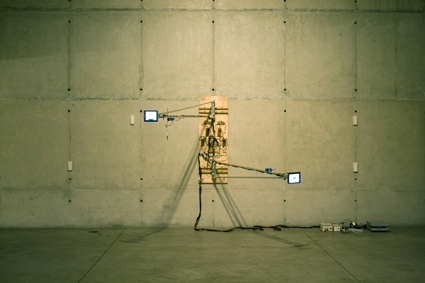Mariana develops works that use image manipulation and have the imagination as a language structure. Videos from the artist’s visual quotidian, such as teapots and old jars that occupy her home’s crystal closet, are inserted in a complex mechanical device created by the artist. The results are robotic organisms that mixture low and high tech elements. A microwave motor, for example, can be seen side by side with an electronic muscle that has the thickness of a hair. “I discovered this material and found very interesting the fact that it acts like a real muscle. The movement that it does when relaxed is exactly what I was looking for my works” says the artist, who has imported this material from California.
The videos are particularly interesting. As if they acquire residue from human behavior, the objects (pots, jars and sugar bowls) are neurotic, repetitive and make obstinate movements. Their voices determine the motor’s behavior: electronic circuits capture musical notes emitted by the videos, putting in action mechanisms and, consequently, moving the body of the work.
In her most recent works, the mechanisms created by Mariana are interconnected and their parts start to act symbiotically. Nevertheless, the works don’t receive external impulse. In this way, the viewers – used to interaction – remain as mere intruders in the robotic world idealized by the artist.
Mariana explains that her creative process is long and involves the elaboration of drawings, photographs and projects. The artist reveals that the final result, many times occurs from situations that happen during the exhibition mounting. For her, these technical issues don’t limit her work; on the contrary, they are intriguing and challenging. According to Mariana, finding solutions to this unexpected events is part of her poetic.
About the artist
Marina Manhães was born in Niterói, Rio de Janeiro. Between 1998 and 2006, she took several courses at Escola de Arte Visuais do Parque Lage. Recent exhibitions include: Arte Para Crianças, Museu Vale do Rio Doce and Museu de Arte Moderna do Rio de Janeiro (2007-08); Futuro do Presente, Instituto Itaú Cultural, São Paulo (2007); Recortar e Colar | CRTL+C_ CRTL+V, SESC Pompéia, São Paulo (2007); Liquescer, Museu de Arte Contemporânea de Niterói (2007); Tomada, Galeria Leme, São Paulo (2007); Geração da Virada ou 10+1, Instituto Tomie Ohtake, São Paulo (2006); É Hoje na Arte Brasileira Contemporânea; Coleção Gilberto Chateaubriand, Santander Cultural, Porto Alegre (2006); 6º Salão de Goiás, Goiânia (2006); 12º Salão da Bahia, Museu de Arte Moderna, Salvador (2005).
